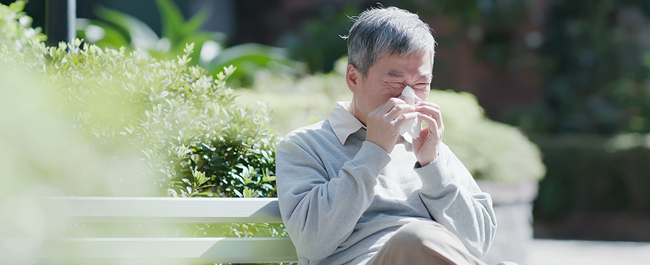5 Things To Know About Seasonal Allergies

April 18, 2022
By Lisa Ryan
Seasonal allergies affect around 20 percent of Americans. Even if you do not have allergies, you probably know someone who does.
We experience seasonal allergy symptoms because of allergens in the air. These allergens trigger an immune response leading to inflammation along the mucous membranes that line your nose, eyes, throat and ears.
Is it allergies or a cold?
Telling the difference between seasonal allergies, a cold, or COVID-19 can be difficult. Longtime sufferers of allergies can usually tell the difference between allergies and a viral illness, but if it’s not clear, there are a few clues to help figure it out.
Allergies may cause:
A cold or other viral illness may cause:
Finally, colds usually run their course in about 14 days. Runny nose or watery eyes lasting longer than that are more likely due to allergies.
If you believe you have a viral illness and are not sure if it is COVID-19, the CDC has an up-to-date list of common COVID-19 symptoms on their website. COVID-19 testing is available through the City of Philadelphia, as well as the Drexel HOPE mobile medical unit and Drexel University’s Dornsife Center for Neighborhood Partnerships.
How are seasonal allergies treated?
Some medications available at the pharmacy without a prescription (“over-the-counter”) can be effective in relieving significant allergic symptoms. But not all medications are right for all people, so you should work with your doctor to figure out the most effective and safest medication for you.
Over-the-counter medications for allergies may include:
- Antihistamines (taken orally or as eyedrops)
- Decongestants
- Nasal steroid sprays
What are the potential side effects of medications for seasonal allergies?
In people under 65, the most common side effect of oral antihistamines is drowsiness.
People over 65 need to be very careful with antihistamines, as they can cause dangerous side effects in addition to drowsiness. If you are over 65, you should check with your doctor before using antihistamines, even if they are over-the-counter.
What are the worst times of the year for different allergies?
Winter: As the heater kicks on and dries out the air, dust allergies are in their prime.
Early spring: Pollen starts flying, and so do pollen- and flower-related allergies.
Late spring: As the grass starts to grow long, those with grass allergies have their toughest time of year.
Summer: Heat combined with some summer showers is the perfect recipe for mold growth. Mold-related allergies are common this time of year.
Fall: Ragweed blooms in the early fall and can linger for months. With a single ragweed plant capable of delivering a billion pollen grains into the fall breeze, this is one of the most common allergies and one of the most difficult to avoid.
How do I avoid triggers of allergic symptoms?
Awareness is the key to avoiding allergy symptoms. Be mindful of the things you know will cause symptoms (e.g., pets, pollen, grass, dust, mold).
You can reduce your exposure to some allergens by:
- Keeping windows closed
- Using an air conditioner or HEPA air filter
- Drying your clothes indoors instead of outside on a clothesline
- Cleaning the house as often as you are able
The information on these pages is provided for general information only and should not be used for diagnosis or treatment, or as a substitute for consultation with a physician or health care professional. If you have specific questions or concerns about your health, you should consult your health care professional.
The images being used are for illustrative purposes only; any person depicted is a model.
Back to Top